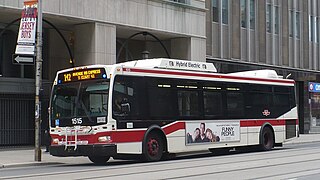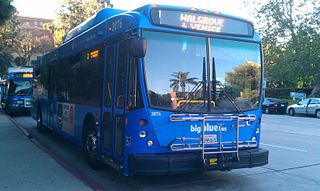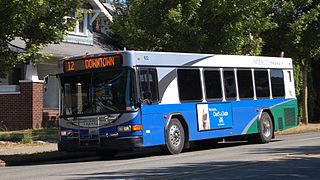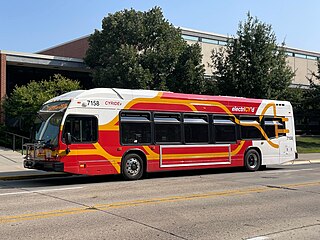The Greater Dayton Regional Transit Authority, formerly known as the Miami Valley RTA, is a public transit agency that generally serves the greater Dayton, Ohio area. The GDRTA serves communities within Montgomery County and parts of Greene County, Ohio, USA. There are 18 routes. RTA operates diesel and electric trolley buses seven days a week, 21 hours a day, and provides services to many citizens within the area. RTA's current CEO is Bob Ruzinsky. In 2023, the system had a ridership of 6,570,600, or about 19,800 per weekday as of the fourth quarter of 2023.

The Toronto Transit Commission (TTC) uses buses and other vehicles for public transportation. In 2018, the TTC bus system had 159 bus routes carrying over 264 million riders over 6,686 kilometres (4,154 mi) of routes with buses travelling 143 million kilometres in the year. As of 2021, the TTC has 192 bus routes in operation, including 28 night bus routes. In 2023, the system had a ridership of 362,041,400, or about 1,222,800 per weekday as of the fourth quarter of 2023.

Big Blue Bus is a municipal bus service primarily serving the city of Santa Monica and the greater Westside region of Los Angeles County, California. The service, operated by the city of Santa Monica, was founded on April 14, 1928 and throughout its existence has used a blue color scheme for its buses, leading to the Big Blue Bus nickname that would later become the official name of the agency. In 2023, the system had a ridership of 8,289,600, or about 29,900 per weekday as of the fourth quarter of 2023. Big Blue Bus receives funding from the Los Angeles County Metropolitan Transportation Authority (Metro) and offers connections to its Metro Bus and Metro Rail systems, but is operated independently from Metro.

CUE Bus (City-University-Energysaver) is a bus service operated by the City of Fairfax, Virginia, and is completely separate from the Fairfax Connector bus service run by Fairfax County. In 2023, the system had a ridership of 945,900, or about 3,400 per weekday as of the fourth quarter of 2023.

Ride on is the primary public transportation system in Montgomery County, Maryland. Managed by the Montgomery County Department of Transportation, Ride On serves Montgomery County as well as the community of Langley Park in Prince George's County and Sibley Memorial Hospital in Washington, D.C. In fiscal 2018, it operated on a US$112.3 million budget. In 2023, the system had a ridership of 16,644,600, or about 58,500 per weekday as of the fourth quarter of 2023.

Driving Alexandria Safely Home (DASH) is the public bus system for the city of Alexandria, Virginia, operated by the Alexandria Transit Company.

San Joaquin Regional Transit District is a transit district that provides bus service to the city of Stockton, California and the surrounding communities of Lodi, Ripon, Thornton, French Camp, Lathrop, Manteca, and Tracy. In 2023, the system had a ridership of 2,432,000, or about 9,100 per weekday as of the fourth quarter of 2023.

Intercity Transit is a public transportation agency organized as a municipal corporation in Thurston County, Washington, United States. It serves Lacey, Olympia, Tumwater, and Yelm: an area of approximately 94 square miles (240 km2). It operates 21 bus routes, the Dial-A-Lift door-to-door service, a vanpool program, and specialized van programs.
TransIT Services of Frederick County is a public transportation agency in Frederick County, Maryland, that is operated by the county government. The agency currently operates 9 Connector bus routes, mostly in the city of Frederick, 5 shuttles, and demand-response for seniors and persons with disabilities. TransIT provides connections to other public transportation services in the region, including the MTA Maryland's routes 204 and 515 commuter bus and MARC Train service. According to the agency's homepage, the service had approximately 909,800 boardings in FY 2012.

VINE Transit is a public transportation service in Napa County, California, United States; it is managed under the Napa Valley Transportation Authority and operated by Transdev. The system offers extensive service throughout the county along with providing connections to other public transportation systems in adjacent counties. In 2023, the system had a ridership of 498,600, or about 1,800 per weekday as of the fourth quarter of 2023.

The Orion VII is a line of low-floor transit buses available in 30' rigid, 35' rigid, and 40' rigid lengths manufactured by Daimler Buses North America's subsidiary Orion Bus Industries between 2001 and 2013 in three generations. The conventional powered buses, either with longitudinally-mounted diesel or natural gas engines, used a T-drive transmission coupling. A series hybrid variant powered by a diesel-driven generator was also available. The Orion VII replaced the fully low-floor Orion VI and high-floor Orion V buses, and was manufactured until its parent company DaimlerChrysler withdrew from the transit bus market in 2013.

CyRide is a partnership between Iowa State University, the ISU Student Government, and Ames, Iowa. CyRide provides public transportation to the community throughout the city of Ames. The word CyRide is a portmanteau of two words: Cy and the word ride. In January 2012, CyRide was recognized "as the nation’s small urban transit system with the highest number of rides per capita" at 106 rides per capita. In 2019, CyRide ranked third in the nation with 110.2 rides per capita, behind the transit systems of New York and San Francisco.

Berks Area Regional Transportation Authority (BARTA), previously Berks Area Reading Transportation Authority, is a public transportation system serving the city of Reading and its surrounding area of Berks County, Pennsylvania. The South Central Transit Authority owns BARTA and the Red Rose Transit Authority (RRTA). In 2023, the system had a ridership of 2,276,000, or about 9,400 per weekday as of the fourth quarter of 2023.
The Greensboro Transit Agency (GTA) is the operator of public transportation in the Greensboro, North Carolina area. It complements three other local and one regional bus service in the Piedmont Triad. Fifteen routes travel almost solely within the city limits. In 2023, the system had a ridership of 2,367,000, or about 8,300 per weekday as of the fourth quarter of 2023.

Merced County Transit, also known as "The Bus", provides public bus transportation services throughout Merced County in the Central Valley and San Joaquin Valley areas of California. Vehicles are owned and maintained by Transit Joint Powers Authority of Merced County with daily operations conducted by a private contractor (Transdev).

SolTrans, officially Solano County Transit, is a Joint Powers Authority that provides public transportation service to the southern Solano County cities of Vallejo and Benicia. SolTrans was established in 2011 and is the result of a merger between Vallejo Transit and Benicia Breeze. In 2023, the system had a ridership of 954,200, or about 3,700 per weekday as of the fourth quarter of 2023.

The Seattle trolleybus system forms part of the public transportation network in the city of Seattle, Washington, operated by King County Metro. Originally opened on April 28, 1940, the network consists of 15 routes, with 174 trolleybuses operating on 68 miles (109 km) of two-way parallel overhead lines. As of the fourth quarter of 2023, the system carries riders on an average of 39,900 trips per weekday, comprising about 18 percent of King County Metro's total daily ridership. At present in Seattle, a very common alternative term for trolleybus is trolley.

The Dayton trolleybus system forms part of the public transportation network serving Dayton, in the state of Ohio, United States. Opened on April 23, 1933, it presently comprises five lines, and is operated by the Greater Dayton Regional Transit Authority, with a fleet of 45 trolleybuses. In 2023, the system had a ridership of 2,163,400, or about 6,400 per weekday as of the fourth quarter of 2023.
As of 2017, King County Metro operates the 10th largest fleet of buses in the United States, with a total of 1,540 buses.

The New Flyer Low Floor is a line of low-floor transit buses that was manufactured by New Flyer Industries between 1991 and 2014. It was available in 30-foot rigid, 35-foot rigid, 40-foot rigid, and 60-foot articulated lengths. In addition to the different available lengths, the buses were sold with a variety of prime movers, ranging from conventional diesel and CNG combustion engines to diesel-electric hybrid, gasoline hybrid, and hydrogen fuel cell.

















